Yichen Zhang
Central South University
StatEval: A Comprehensive Benchmark for Large Language Models in Statistics
Oct 10, 2025Abstract:Large language models (LLMs) have demonstrated remarkable advances in mathematical and logical reasoning, yet statistics, as a distinct and integrative discipline, remains underexplored in benchmarking efforts. To address this gap, we introduce \textbf{StatEval}, the first comprehensive benchmark dedicated to statistics, spanning both breadth and depth across difficulty levels. StatEval consists of 13,817 foundational problems covering undergraduate and graduate curricula, together with 2374 research-level proof tasks extracted from leading journals. To construct the benchmark, we design a scalable multi-agent pipeline with human-in-the-loop validation that automates large-scale problem extraction, rewriting, and quality control, while ensuring academic rigor. We further propose a robust evaluation framework tailored to both computational and proof-based tasks, enabling fine-grained assessment of reasoning ability. Experimental results reveal that while closed-source models such as GPT5-mini achieve below 57\% on research-level problems, with open-source models performing significantly lower. These findings highlight the unique challenges of statistical reasoning and the limitations of current LLMs. We expect StatEval to serve as a rigorous benchmark for advancing statistical intelligence in large language models. All data and code are available on our web platform: https://stateval.github.io/.
ContentV: Efficient Training of Video Generation Models with Limited Compute
Jun 05, 2025Abstract:Recent advances in video generation demand increasingly efficient training recipes to mitigate escalating computational costs. In this report, we present ContentV, an 8B-parameter text-to-video model that achieves state-of-the-art performance (85.14 on VBench) after training on 256 x 64GB Neural Processing Units (NPUs) for merely four weeks. ContentV generates diverse, high-quality videos across multiple resolutions and durations from text prompts, enabled by three key innovations: (1) A minimalist architecture that maximizes reuse of pre-trained image generation models for video generation; (2) A systematic multi-stage training strategy leveraging flow matching for enhanced efficiency; and (3) A cost-effective reinforcement learning with human feedback framework that improves generation quality without requiring additional human annotations. All the code and models are available at: https://contentv.github.io.
Towards Self-Improvement of Diffusion Models via Group Preference Optimization
May 16, 2025Abstract:Aligning text-to-image (T2I) diffusion models with Direct Preference Optimization (DPO) has shown notable improvements in generation quality. However, applying DPO to T2I faces two challenges: the sensitivity of DPO to preference pairs and the labor-intensive process of collecting and annotating high-quality data. In this work, we demonstrate that preference pairs with marginal differences can degrade DPO performance. Since DPO relies exclusively on relative ranking while disregarding the absolute difference of pairs, it may misclassify losing samples as wins, or vice versa. We empirically show that extending the DPO from pairwise to groupwise and incorporating reward standardization for reweighting leads to performance gains without explicit data selection. Furthermore, we propose Group Preference Optimization (GPO), an effective self-improvement method that enhances performance by leveraging the model's own capabilities without requiring external data. Extensive experiments demonstrate that GPO is effective across various diffusion models and tasks. Specifically, combining with widely used computer vision models, such as YOLO and OCR, the GPO improves the accurate counting and text rendering capabilities of the Stable Diffusion 3.5 Medium by 20 percentage points. Notably, as a plug-and-play method, no extra overhead is introduced during inference.
Active Contact Engagement for Aerial Navigation in Unknown Environments with Glass
May 01, 2025Abstract:Autonomous aerial robots are increasingly being deployed in real-world scenarios, where transparent glass obstacles present significant challenges to reliable navigation. Researchers have investigated the use of non-contact sensors and passive contact-resilient aerial vehicle designs to detect glass surfaces, which are often limited in terms of robustness and efficiency. In this work, we propose a novel approach for robust autonomous aerial navigation in unknown environments with transparent glass obstacles, combining the strengths of both sensor-based and contact-based glass detection. The proposed system begins with the incremental detection and information maintenance about potential glass surfaces using visual sensor measurements. The vehicle then actively engages in touch actions with the visually detected potential glass surfaces using a pair of lightweight contact-sensing modules to confirm or invalidate their presence. Following this, the volumetric map is efficiently updated with the glass surface information and safe trajectories are replanned on the fly to circumvent the glass obstacles. We validate the proposed system through real-world experiments in various scenarios, demonstrating its effectiveness in enabling efficient and robust autonomous aerial navigation in complex real-world environments with glass obstacles.
CascadeV: An Implementation of Wurstchen Architecture for Video Generation
Jan 28, 2025Abstract:Recently, with the tremendous success of diffusion models in the field of text-to-image (T2I) generation, increasing attention has been directed toward their potential in text-to-video (T2V) applications. However, the computational demands of diffusion models pose significant challenges, particularly in generating high-resolution videos with high frame rates. In this paper, we propose CascadeV, a cascaded latent diffusion model (LDM), that is capable of producing state-of-the-art 2K resolution videos. Experiments demonstrate that our cascaded model achieves a higher compression ratio, substantially reducing the computational challenges associated with high-quality video generation. We also implement a spatiotemporal alternating grid 3D attention mechanism, which effectively integrates spatial and temporal information, ensuring superior consistency across the generated video frames. Furthermore, our model can be cascaded with existing T2V models, theoretically enabling a 4$\times$ increase in resolution or frames per second without any fine-tuning. Our code is available at https://github.com/bytedance/CascadeV.
Journey into Automation: Image-Derived Pavement Texture Extraction and Evaluation
Jan 05, 2025
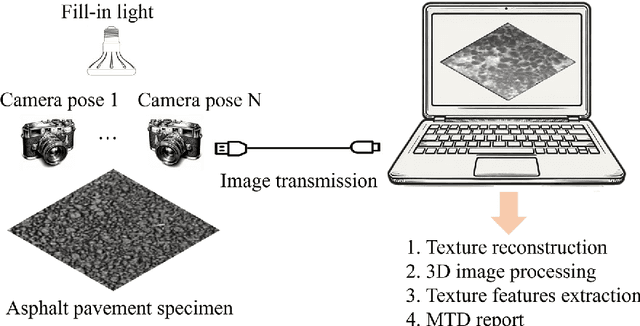
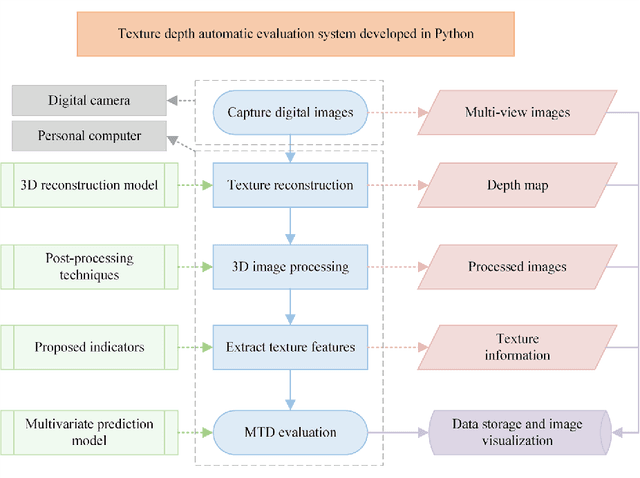

Abstract:Mean texture depth (MTD) is pivotal in assessing the skid resistance of asphalt pavements and ensuring road safety. This study focuses on developing an automated system for extracting texture features and evaluating MTD based on pavement images. The contributions of this work are threefold: firstly, it proposes an economical method to acquire three-dimensional (3D) pavement texture data; secondly, it enhances 3D image processing techniques and formulates features that represent various aspects of texture; thirdly, it establishes multivariate prediction models that link these features with MTD values. Validation results demonstrate that the Gradient Boosting Tree (GBT) model achieves remarkable prediction stability and accuracy (R2 = 0.9858), and field tests indicate the superiority of the proposed method over other techniques, with relative errors below 10%. This method offers a comprehensive end-to-end solution for pavement quality evaluation, from images input to MTD predictions output.
GS-Net: Generalizable Plug-and-Play 3D Gaussian Splatting Module
Sep 17, 2024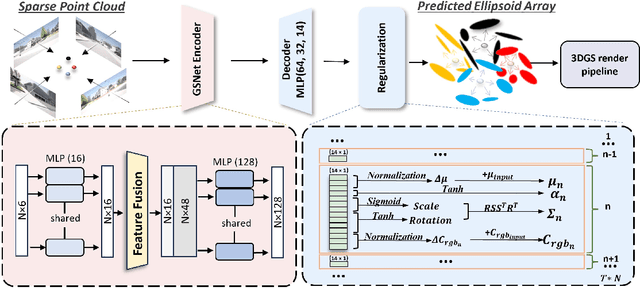

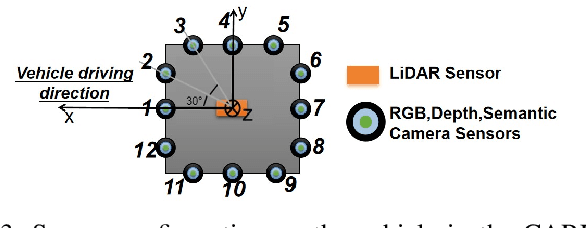
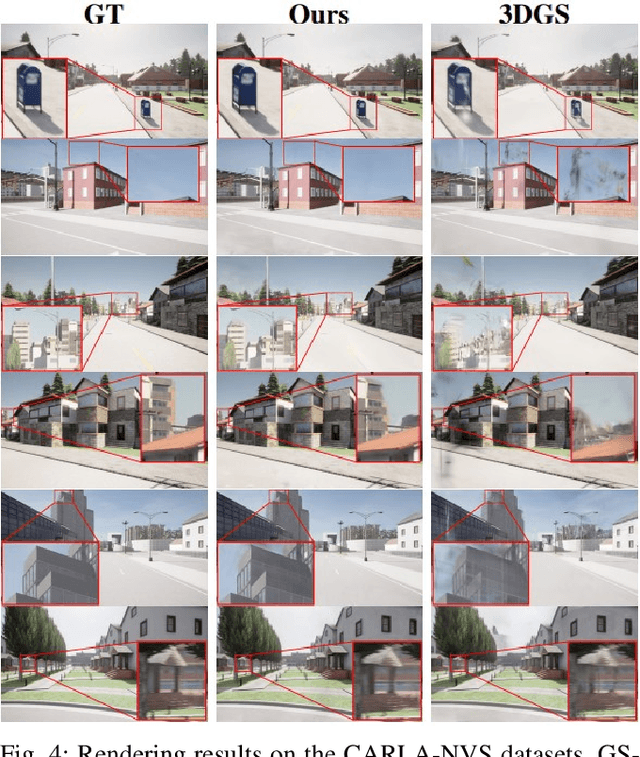
Abstract:3D Gaussian Splatting (3DGS) integrates the strengths of primitive-based representations and volumetric rendering techniques, enabling real-time, high-quality rendering. However, 3DGS models typically overfit to single-scene training and are highly sensitive to the initialization of Gaussian ellipsoids, heuristically derived from Structure from Motion (SfM) point clouds, which limits both generalization and practicality. To address these limitations, we propose GS-Net, a generalizable, plug-and-play 3DGS module that densifies Gaussian ellipsoids from sparse SfM point clouds, enhancing geometric structure representation. To the best of our knowledge, GS-Net is the first plug-and-play 3DGS module with cross-scene generalization capabilities. Additionally, we introduce the CARLA-NVS dataset, which incorporates additional camera viewpoints to thoroughly evaluate reconstruction and rendering quality. Extensive experiments demonstrate that applying GS-Net to 3DGS yields a PSNR improvement of 2.08 dB for conventional viewpoints and 1.86 dB for novel viewpoints, confirming the method's effectiveness and robustness.
UniQuad: A Unified and Versatile Quadrotor Platform Series for UAV Research and Application
Jun 30, 2024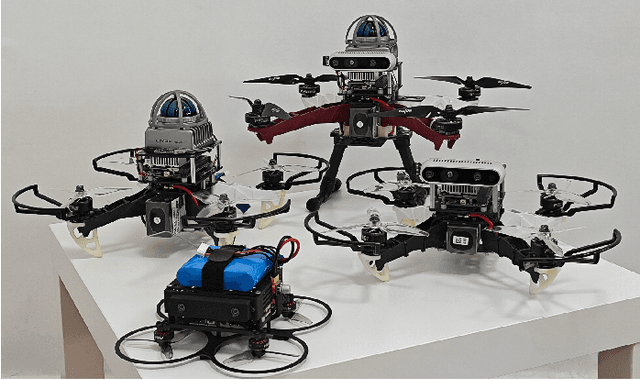


Abstract:As quadrotors take on an increasingly diverse range of roles, researchers often need to develop new hardware platforms tailored for specific tasks, introducing significant engineering overhead. In this article, we introduce the UniQuad series, a unified and versatile quadrotor platform series that offers high flexibility to adapt to a wide range of common tasks, excellent customizability for advanced demands, and easy maintenance in case of crashes. This project is fully open-source at https://hkust-aerial-robotics.github.io/UniQuad.
FALCON: Fast Autonomous Aerial Exploration using Coverage Path Guidance
Jun 30, 2024



Abstract:This paper introduces FALCON, a novel Fast Autonomous expLoration framework using COverage path guidaNce, which aims at setting a new performance benchmark in the field of autonomous aerial exploration. Despite recent advancements in the domain, existing exploration planners often suffer from inefficiencies such as frequent revisitations of previously explored regions. FALCON effectively harnesses the full potential of online generated coverage paths in enhancing exploration efficiency. The framework begins with an incremental connectivity-aware space decomposition and connectivity graph construction, which facilitate efficient coverage path planning. Subsequently, a hierarchical planner generates a coverage path spanning the entire unexplored space, serving as a global guidance. Then, a local planner optimizes the frontier visitation order, minimizing traversal time while consciously incorporating the intention of the global guidance. Finally, minimum-time smooth and safe trajectories are produced to visit the frontier viewpoints. For fair and comprehensive benchmark experiments, we introduce a lightweight exploration planner evaluation environment that allows for comparing exploration planners across a variety of testing scenarios using an identical quadrotor simulator. Additionally, a VECO criteria is proposed for an in-depth analysis of FALCON's significant performance in comparison with the state-of-the-art exploration planners. Extensive ablation studies demonstrate the effectiveness of each component in the proposed framework. Real-world experiments conducted fully onboard further validate FALCON's practical capability in complex and challenging environments. The source code of both the exploration planner FALCON and the exploration planner evaluation environment will be released to benefit the community.
PetalView: Fine-grained Location and Orientation Extraction of Street-view Images via Cross-view Local Search with Supplementary Materials
Jun 19, 2024



Abstract:Satellite-based street-view information extraction by cross-view matching refers to a task that extracts the location and orientation information of a given street-view image query by using one or multiple geo-referenced satellite images. Recent work has initiated a new research direction to find accurate information within a local area covered by one satellite image centered at a location prior (e.g., from GPS). It can be used as a standalone solution or complementary step following a large-scale search with multiple satellite candidates. However, these existing works require an accurate initial orientation (angle) prior (e.g., from IMU) and/or do not efficiently search through all possible poses. To allow efficient search and to give accurate prediction regardless of the existence or the accuracy of the angle prior, we present PetalView extractors with multi-scale search. The PetalView extractors give semantically meaningful features that are equivalent across two drastically different views, and the multi-scale search strategy efficiently inspects the satellite image from coarse to fine granularity to provide sub-meter and sub-degree precision extraction. Moreover, when an angle prior is given, we propose a learnable prior angle mixer to utilize this information. Our method obtains the best performance on the VIGOR dataset and successfully improves the performance on KITTI dataset test 1 set with the recall within 1 meter (r@1m) for location estimation to 68.88% and recall within 1 degree (r@1d) 21.10% when no angle prior is available, and with angle prior achieves stable estimations at r@1m and r@1d above 70% and 21%, up to a 40-degree noise level.
* This paper has been accepted by ACM Multimedia 2023. This version contains additional supplementary materials
 Add to Chrome
Add to Chrome Add to Firefox
Add to Firefox Add to Edge
Add to Edge